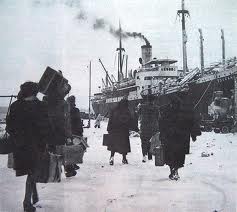|
Norma Cossetto
Norma Cossetto (17 May 1920 – 4/5 October 1943) was an Istrian Italian student, killed by the League of Communists of Yugoslavia, Yugoslavian communists and thrown into a ''Foibe killings, foiba''. Life The Cossetto family lived in the hamlet of Santa Domenica in Visinada (today ''Vižinada'', Croatia), where Norma was born in 1920. Her father, Giuseppe, was a local leader of the Fascist National Party: he had held several posts and also served as ''podestà'' (mayor) of Visinada. He enlisted to the Blackshirts, Voluntary Militia for National Security and, after the Armistice of Cassibile, Armistice between Italy and the Allies was made public on 8 September 1943, he was deployed to Trieste. Norma had attended the ''Regio Liceo Vittorio Emanuele III'' in Gorizia; after her graduation, she enrolled at the University of Padova and studied Italian Literature, while also joining the Fascist University Group in Pula, Pola. Since 1941, she had worked as a substitute teacher in Pisi ... [...More Info...] [...Related Items...] OR: [Wikipedia] [Google] [Baidu] |
Carabinieri
The Carabinieri (, also , ; formally ''Arma dei Carabinieri'', "Arm of Carabineers"; previously ''Corpo dei Carabinieri Reali'', "Royal Carabineers Corps") are the national gendarmerie of Italy who primarily carry out domestic and foreign policing duties. It is one of Italy's main law enforcement agencies, alongside the Polizia di Stato and the Guardia di Finanza. As with the Guardia di Finanza but in contrast to the Polizia di Stato, the Carabinieri are a military force. As the fourth branch of the Italian Armed Forces, they come under the authority of the Ministry of Defence; for activities related to inland public order and security, they functionally depend on the Ministry of the Interior. In practice, there is a significant overlap between the jurisdiction of the Polizia di Stato and Carabinieri, although both of them are contactable through 112, the European Union's Single Emergency number. Unlike the Polizia di Stato, the Carabinieri have responsibility for policing the ... [...More Info...] [...Related Items...] OR: [Wikipedia] [Google] [Baidu] |
List Of Kidnappings
The following is a list of kidnappings summarizing the events of each individual case, including instances of celebrity abductions, claimed hoaxes, suspected kidnappings, extradition abductions, and mass kidnappings. Before 1900 1900–1949 1950–1979 1980–1989 1990–1999 2000–2009 2010–2019 2020s and later Modern kidnappings of celebrities or their relatives Kidnappers interested in getting a large ransom or a political effect often target celebrities or their relatives. Here are some of the people affected by these crimes: *Leon Ames: Film and television actor who, together with his wife, was held hostage at their home on February 12, 1964. They were rescued by police, who had been alerted to the case by his business partner. *Leonard Firestone (57–58), American businessman, philanthropist, diplomat was the target of an aborted kidnapped plan that was to take place in 1966. *Cindy Birdsong: A member of the Motown supergroup The Supremes. Birdsong ... [...More Info...] [...Related Items...] OR: [Wikipedia] [Google] [Baidu] |
Terni
Terni ( , ; lat, Interamna (Nahars)) is a city in the southern portion of the region of Umbria in central Italy. It is near the border with Lazio. The city is the capital of the province of Terni, located in the plain of the Nera river. It is northeast of Rome and 81 km south of the regional capital, Perugia. The Latin name means "between-two-rivers", in reference to its location on the confluence of the Nera river Nera may refer to: People * Nera Smajic (born 1984), Bosnian-born Swedish footballer * Nera Stipičević (born 1983), Croatian actress * Nera White (1935–2016), American basketball player * André António Ribeiro Novais (born 1988), Portuguese ... ( Ancient Umbrian ''Nahar'', lat, Nār, Nahar) and the Serra stream. When disambiguation was needed, it was referred to as ''Interamna Nahars''. Its inhabitants were known in Latin as ''Interamnātēs Na(ha)rtēs''. Interamna was founded as an Ancient Roman town, albeit settlements in the Terni area well precede th ... [...More Info...] [...Related Items...] OR: [Wikipedia] [Google] [Baidu] |
Narni
Narni (in Latin, Narnia) is an ancient hilltown and ''comune'' of Umbria, in central Italy, with 19,252 inhabitants (2017). At an altitude of 240 m (787 ft), it overhangs a narrow gorge of the Nera River in the province of Terni. It is very close to the geographic center of Italy.Narni – Journey to the Center of Italy Goeurope.about.com. Retrieved on 2017-10-29. There is a stone on the exact spot with a sign in multiple languages. Goeurope.about.com. Retrieved on 2017-10-29. History The area around Narni was already inhabited in the |
National Memorial Day Of The Exiles And Foibe
National Memorial Day of the Exiles and Foibe, or ''Giorno del ricordo'' in Italian language (English: Day of Remembrance), is an Italian celebration for the memory of the Foibe massacres, victims of the Foibe and the Istrian–Dalmatian exodus, which led to the emigration of hundreds of thousands (between 230,000 to 350,000) of local ethnic Italians (Istrian Italians and Dalmatian Italians) from Socialist Federal Republic of Yugoslavia, Yugoslavia after the end of the Second World War. The Italian Law 92 of 30 March 2004 instituted a ''Day of Remembrance'' on 10 February to commemorate the victims of Foibe and the forced exodus of nearly the entire population of Italian origin living in Dalmatia and Julian March brought about by Yugoslavia. The law also instituted a special medal to be conferred on relatives of victims. The date of 10 February is the day on which the Paris Peace Treaties of 1947, peace treaties of Paris were signed. These treaties transferred the previously Itali ... [...More Info...] [...Related Items...] OR: [Wikipedia] [Google] [Baidu] |
Carlo Azeglio Ciampi
Carlo Azeglio Ciampi (; 9 December 1920 – 16 September 2016) was an Italian politician and banker who was the prime minister of Italy from 1993 to 1994 and the president of Italy from 1999 to 2006. Biography Education Ciampi was born in Livorno (Province of Livorno).Page at Senate website . He received a B.A. in and in 1941 from the |
Ethnic Cleansing
Ethnic cleansing is the systematic forced removal of ethnic, racial, and religious groups from a given area, with the intent of making a region ethnically homogeneous. Along with direct removal, extermination, deportation or population transfer, it also includes indirect methods aimed at forced migration by coercing the victim group to flee and preventing its return, such as murder, rape, and property destruction. It constitutes a crime against humanity and may also fall under the Genocide Convention, even as ''ethnic cleansing'' has no legal definition under international criminal law. Many instances of ethnic cleansing have occurred throughout history; the term was first used by the perpetrators as a euphemism during the Yugoslav Wars in the 1990s. Since then, the term has gained widespread acceptance due to journalism and the media's heightened use of the term in its generic meaning. Etymology An antecedent to the term is the Greek word (; lit. "enslavement"), which was ... [...More Info...] [...Related Items...] OR: [Wikipedia] [Google] [Baidu] |
Foibe Massacres
The foibe massacres (; ; ), or simply the foibe, refers to mass killings both during and after World War II, mainly committed by Yugoslav Partisans and OZNA in the Italian Empire, then-Italian territories of Julian March (Karst Region and Istria), Kvarner and Dalmatia, against the local ethnic Italian population (Istrian Italians and Dalmatian Italians), as well the ethnic Slovenes, Croats and Istro-Romanians who chose to maintain Italian citizenship, against all anti-communism, anti-communists, associated with Fascism, Nazism and collaboration with Axis powers, Axis, and against real, potential or presumed opponents of Titoism, Tito communism. The type of attack was state terrorism, Reprisal, reprisal killings, and ethnic cleansing against Italians. The Yugoslav partisans intended to kill whoever could oppose or compromise the future annexation of Italian territories: as a preventive purge of real, potential or presumed opponents of Titoism, Tito communism (Italian, Slovenian an ... [...More Info...] [...Related Items...] OR: [Wikipedia] [Google] [Baidu] |
Piran
Piran (; it, Pirano ) is a town in southwestern Slovenia on the Gulf of Piran on the Adriatic Sea. It is one of the three major towns of Slovenian Istria. The town is known for its medieval architecture, with narrow streets and compact houses. Piran is the administrative seat of the Municipality of Piran and one of Slovenia's major tourist attractions. Until the mid-20th century, Italian was the dominant language, but it was replaced by Slovene following the Istrian exodus. History In the pre-Roman era, the hills in the Piran area were inhabited by Illyrian Histri tribes who were farmers, hunters and fishermen. They were also pirates who disrupted Roman trade in the northern Adriatic. The Piran peninsula was incorporated into the Roman Empire in 178 and 177 BC and settled in the following years with rural homes (''villae rusticae''). The decline of the Roman Empire, from the 5th century AD onward, and incursions by the Avars and Slavs at the end of the 6th century, promp ... [...More Info...] [...Related Items...] OR: [Wikipedia] [Google] [Baidu] |
Foibe Massacres
The foibe massacres (; ; ), or simply the foibe, refers to mass killings both during and after World War II, mainly committed by Yugoslav Partisans and OZNA in the Italian Empire, then-Italian territories of Julian March (Karst Region and Istria), Kvarner and Dalmatia, against the local ethnic Italian population (Istrian Italians and Dalmatian Italians), as well the ethnic Slovenes, Croats and Istro-Romanians who chose to maintain Italian citizenship, against all anti-communism, anti-communists, associated with Fascism, Nazism and collaboration with Axis powers, Axis, and against real, potential or presumed opponents of Titoism, Tito communism. The type of attack was state terrorism, Reprisal, reprisal killings, and ethnic cleansing against Italians. The Yugoslav partisans intended to kill whoever could oppose or compromise the future annexation of Italian territories: as a preventive purge of real, potential or presumed opponents of Titoism, Tito communism (Italian, Slovenian an ... [...More Info...] [...Related Items...] OR: [Wikipedia] [Google] [Baidu] |
Antignana
Tinjan ( it, Antignana) is a village and municipality in Istria, Croatia. The total population is 1,684 (2011 census), distributed in the following settlements: * Brčići, population 100 * Brečevići, population 187 * Jakovici, population 268 * Kringa, population 315 * Muntrilj, population 77 * Radetići, population 210 * Tinjan, population 417 * Žužići, population 110 Tinjan is located is 50 km north of Pula and 10 km southwest of Pazin Pazin ( it, Pisino, german: Mitterburg) is a town in western Croatia, the administrative seat of Istria County. It is known for the medieval Pazin Castle, the former residence of the Istrian margraves. Geography The town had a population of 8,6 ..., in the Draga valley. The Coat of Arms of Tinjan is azure on a base vert a tower argent behind walls of the same. This is based on the historical pattern. References External links Official siteOfficial tourist infoKarate club Tinjan Municipalities of Croatia Populated pl ... [...More Info...] [...Related Items...] OR: [Wikipedia] [Google] [Baidu] |






